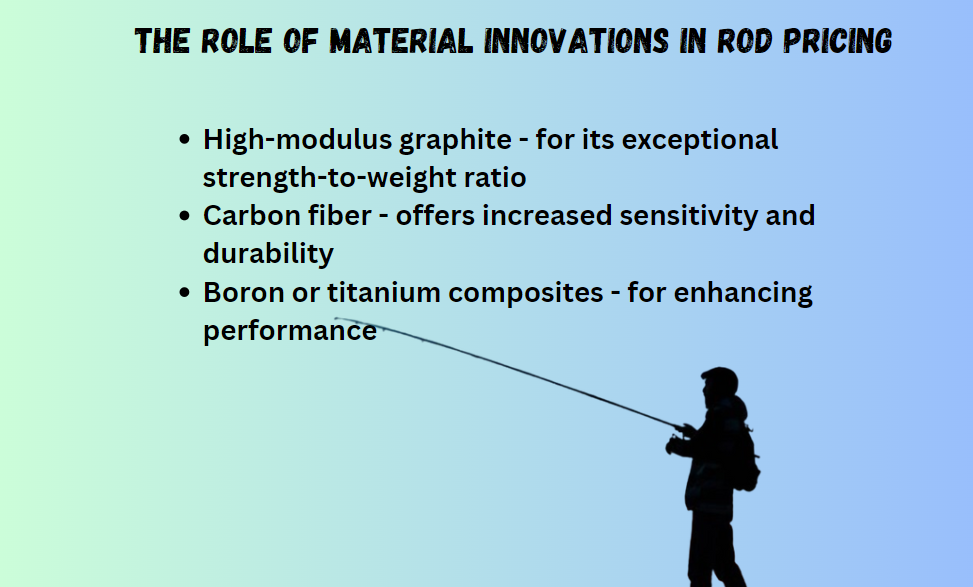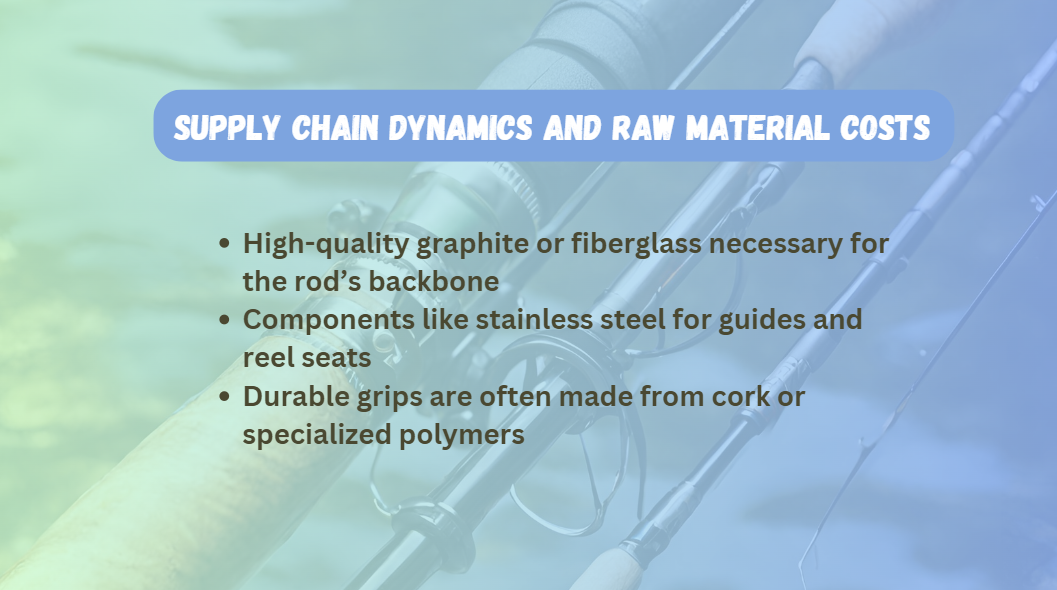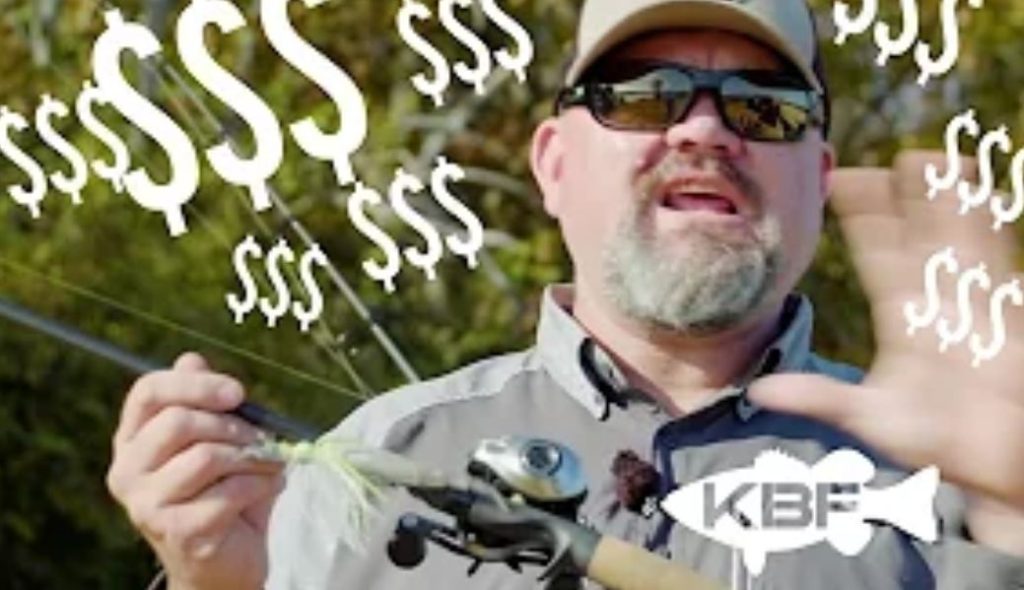Fishing rods can be expensive due to advanced materials and craftsmanship. They also often incorporate technology for improved performance.
Fishing enthusiasts constantly search for the perfect rod to enhance their angling experience. This quest leads them to high-end rods constructed with sophisticated materials like graphite or carbon fiber, designed to offer strength, flexibility, and sensitivity. These attributes are crucial for successfully catching game fish.
Expert craftsmanship also plays a pivotal role; a carefully designed rod can significantly improve casting accuracy and fish handling. Some rods are tailored to specific types of fishing, requiring precise design and the integration of intricate components. To cater to such demands, manufacturers invest in research and development, further driving up costs. A premium rod not only promises a better catch but also ensures durability and longevity, which are essential for anglers who consider fishing more than just a hobby. Why are Fishing Rods So Expensive?
Understanding The Cost Drivers Behind High-quality Fishing Rods
Fishing enthusiasts often wonder why the price tag on high-quality fishing rods can soar as high as the fish they aim to catch. The reasons go beyond simple aesthetics or brand prestige; they investigate into the realms of advanced material engineering, meticulous craftsmanship, and cutting-edge innovation. A closer look at the cost drivers unveils the complexity and precision involved in creating these sophisticated tools of the angling trade.
The Role Of Material Innovations In Rod Pricing

One of the primary factors influencing the price of premium fishing rods is the material used in their construction. Advances in technology have enabled the integration of revolutionary materials such as:
- High-modulus graphite – for its exceptional strength-to-weight ratio
- Carbon fiber – offers increased sensitivity and durability
- Boron or titanium composites – for enhancing performance
These innovations create rods that are not only lightweight and responsive but also robust enough to withstand the rigorous demands of angling. The research, acquisition, and processing of these materials undeniably contribute to the final cost of the fishing rod.
Craftsmanship And Labor: The Art Behind The Rod
Creating a high-caliber fishing rod is an art where expertise and precision are mandatory. The process often involves:
| Step | Description |
|---|---|
| Design | Customized rod blueprints to match specific fishing needs and styles |
| Handcrafting | Assembling and finishing each rod by hand to ensure quality |
| Inspection | Detailed quality checks at every stage of production |
This intensive craftsmanship and labor drives up the production costs but results in a superior product that performs exceptionally in a variety of fishing conditions and techniques.
Research And Development Expenses
Fishing rod manufacturers dedicate a significant portion of their budget to RD to outperform competitors and meet the evolving needs of anglers. This includes:
- Thorough testing of prototypes in diverse environments
- Collaborating with professionals for feedback and insights
- Continuously refining designs for optimal functionality and performance
The cost of these activities is substantial but crucial for maintaining a reputation for quality and innovation in the competitive market of fishing gear. Consequently, these expenses are reflected in the pricing of high-quality fishing rods.
The Economics Of Fishing Rod Production
Understanding the cost behind fishing rods involves delving into the economic intricacies of production. Anglers often question the high price tags on premium fishing gear. This skepticism is reasonable until one explores the complex journey from raw materials to the final product. The price reflects various factors, such as supply chain dynamics, raw material costs, manufacturing processes, and distribution expenses. Let’s take a closer look at each element to comprehend why fishing rods are so costly.
Supply Chain Dynamics And Raw Material Costs

The price of a fishing rod starts to accumulate long before it takes shape. Elements flowing through the supply chain add layers of cost that resonate in the retail price. Think of the raw materials first:
- High-quality graphite or fiberglass necessary for the rod’s backbone
- Components like stainless steel for guides and reel seats
- Durable grips are often made from cork or specialized polymers
Market demand and availability influence these raw materials’ global prices. Plus, fluctuations in transportation and labor costs in sourcing these materials can drive up the base cost significantly.
Manufacturing Processes: Handcrafted Vs. Mass-produced
The level of craftsmanship that goes into a fishing rod can greatly affect its cost. Handcrafted rods made by seasoned artisans cater to the high-end market. These rods promise superior performance and customizations tailored to the angler’s preferences.
In contrast, mass-produced rods benefit from economies of scale but may lack the unique touch and attention to detail that hand-building provides. The process involves:
- Cutting and shaping of the materials
- Application of intricate guides and bindings
- Meticulous quality checks and finishing treatments
Handcrafted rods require more labor and time, driving up the final price. Even with technological advancements, a significant portion of the manufacturing process is hard to automate, keeping the costs associated with labor relatively high.
Distribution And Retail Markups
Once a fishing rod leaves the manufacturing floor, its journey to your hands is far from over. Distribution involves warehouses, logistics, and transit—all adding to the cumulative cost. Upon arriving at retail stores, another substantial markup is added to ensure profitability. Consider the following:
- Retailers account for operational costs, including staff salaries, utilities, and rent
- Marketing and advertising efforts to capture the angler’s attention
- After-sales services like warranties and returns necessitate a buffer in the pricing
Thus, these markups are not arbitrary but rather rooted in the reality of bringing a product to market and maintaining a business. They contribute significantly to the retail price of a fishing rod.
The Specialization Factor
The quest for the perfect catch often leads anglers to invest in high-quality gear, and the heart of that gear is the fishing rod. While it’s tempting to attribute the cost of fishing rods to mere brand markup, the reality is far more intricate. The Specialization Factor plays a significant role, as rods are not just mere poles to cast a line, but finely tuned instruments designed for specific purposes. Here we investigate into the reasons for the hefty price tag, decoding the economics behind the art of angling.
Rod Customization For Specific Fishing Types
Fishing rods are not a one-size-fits-all tool. Each rod is engineered to excel in certain scenarios, which can range from deep-sea fishing to fly-fishing in mountain streams. Customization is key, and anglers are often seeking rods tailored to their style of fishing and the conditions they face. This specialized manufacturing process involves:
- Selective Material Choice: High-performance materials such as graphite or carbon fiber are preferred for their strength-to-weight ratio.
- Length and Action Customization: Each fishing method demands a different type of rod flex and responsiveness.
- Guides and Grips: Custom fittings that match the angler’s preferences add to the cost, ranging from ergonomic grips to ceramic guides.
Targeting Niche Markets And The Influence On Price
As manufacturers cater to specialized segments within the fishing community, the cost of production often increases. Targeting niche markets means producing smaller quantities of each rod type, which leads to less economy of scale. Consequently, the price per unit rises. In addition, niche markets are characterized by consumers who are willing to pay a premium for a product that meets their specific needs, influencing the overall pricing strategy.
Collaborations With Professional Anglers And Endorsements
Another facet of this specialization is the partnership between manufacturers and top-tier anglers. These collaborations result in high-end rods designed with input from professionals, yielding equipment crafted for peak performance. This not only Fosters the credibility of the brand but also adds to the cost. Endorsements from these pros serve as a testament to the rod’s caliber, but they also form part of the expense, as anglers are not just buying a fishing rod; they’re investing in a piece of expert-endorsed technology.
Technology And Innovation In Fishing Rods

As the sport and leisure activity of fishing has evolved, so too has the equipment used by anglers around the world. Modern fishing rods are more than just a stick and a line; they are complex implements that benefit from years of engineering and innovation. The marriage of technology and craftsmanship in fishing rods accounts for the varying prices, particularly at the higher end of the market. Let’s reel in some of the leading-edge advancements that justify these costs.
Integration Of Smart Technology And Electronics
Fishing has entered the digital age with smart rod technology enhancing the experience on the water. Fishing rods are now incorporating:
- Sensors to detect nibbles and alert the angler.
- Bluetooth connectivity for data transfer to smartphones or tablets.
- GPS tracking to log fishing spots and monitor conditions.
These innovations are not just gimmicks; they provide real-world benefits to anglers. A prime example is bite detection technology, which uses electronics to signal a catch, making fishing more accessible, especially in challenging conditions. This infusion of high-tech components into the construction of fishing rods significantly increases their price point.
Advancements In Durability And Flexibility
The backbone of any good fishing rod is its ability to withstand tension and flex when required. Modern fishing rods benefit from:
- High-grade materials such as carbon fiber and graphene.
- Innovative layering techniques to enhance durability without sacrificing flexibility.
- Nano-resin technology, improving impact resistance.
These advancements have resulted in rods that last longer and perform better. With materials typically reserved for aerospace and military applications, fishing rods can now achieve a balance of strength and elasticity that was once unimaginable. Such properties are key for anglers facing large and strong fish, translating into higher costs for these state-of-the-art rods.
Patents And Proprietary Features
Many high-end rods boast features protected by patents and intellectual property rights. This includes:
- Unique handle designs for better grip and comfort.
- Exclusive reel mounting systems.
- Customizable action and taper of rods tailored to specific fishing conditions.
Companies invest heavily in research and development to create these distinctive features. Protecting their innovations through patents means these features are exclusive to their brand, often for a considerable period. Allowing anglers unique advantages in their pursuit of fish, these proprietary technologies add to the overall cost due to the uniqueness and protected design of the rods.
The high cost of fishing rods is a reflection of their technological sophistication and innovation. From smart sensors to lightweight yet sturdy materials, these fishing tools are designed to provide an unparalleled experience on the water. As patents protect unique features, companies can justify their prices, offering anglers tools that could give them the upper hand in both competitive and recreational fishing scenarios.
Consumer Perception And Brand Value Impact
The intriguing question of why fishing rods can have such hefty price tags often leads anglers to consider the influence of consumer perception and brand value. In the fishing gear market, the allure of prestige, as well as the promise of quality, play pivotal roles in determining how high a price can soar. This portion of our discussion investigates into why certain brands can command top dollar, dissecting the strategies and perceptions that contribute to their pricing.
Premium Branding Strategies And Marketing
Top-tier fishing rod manufacturers are adept at crafting a narrative that is as captivating as the rush of reeling in a big catch. These narratives, combined with strategic marketing efforts, create an illustrious reputation for their brand that can justify an upscale price. Here’s how they do it:
- Endorsements: Associations with professional anglers and celebrities imbue the brand with a sense of expertise and exclusivity.
- Sponsorship of Competitions: Brands become household names when they are seen sponsoring high-profile fishing tournaments.
- Advertising: Slick ads across multiple media platforms ensure the brand stays in the public eye, constantly reminding consumers of its presence.
These strategies converge to create a halo effect around the brand, elevating consumer perception beyond just the physical product to an experience or lifestyle that they’re buying into.
Perceived Value Vs. Actual Performance
There’s always a debate between what consumers think they’re paying for and what they are actually getting. High-end fishing rods, with their steep prices, claim to offer not only superior materials and construction but also an enhanced fishing experience. Nonetheless, the perceived value can sometimes overshadow the actual gains in performance:
- Durability: While expensive rods might use high-quality components, the actual longevity can vary.
- Technology: Cutting-edge features are often touted, yet may offer marginal benefits to the average fisher.
- Comfort and Usability: Comfortable grips and ergonomic designs do matter, but at a point, they hit a plateau where the cost doesn’t correspond to the improvement.
Awareness of these factors encourages consumers to scrutinize whether the performance of a rod is truly reflected in its price.
Case Studies: Comparing Cost And Brand Reputation
By looking at real-world examples, the dynamics between cost and brand reputation are laid bare. Consider the following comparisons:
| Brand | Price Range | Key Features | Market Perception |
|---|---|---|---|
| Brand A | $500 – $1000 | Ultra-lightweight build, proprietary technology | Seen as the pinnacle of rod engineering, often a status symbol among anglers |
| Brand B | $200 – $400 | High-quality materials, proven durability | Respected by enthusiasts for performance, considered a smart, value-driven choice |
Brand A’s pricing strategy relies heavily on its reputation as an industry leader, promising cutting-edge innovation. Brand B, on the other hand, positions itself as offering reliable quality without breaking the bank. Despite the stark differences in price, many consumers remain loyal to their chosen brand, which is a testament to how strong branding can sway perception and, ultimately, the buying decision.
Navigating The Market: Price Vs. Quality Trade-offs
Understanding the balance between price and quality is crucial for anglers on the hunt for the perfect fishing rod. With an array of options available, ranging from budget-friendly rods to high-end models, the task of selecting the right one can seem daunting. The market presents a spectrum of trade-offs where spending more often equates to superior materials and craftsmanship, which can significantly enhance your fishing experience.
Yet, not all expensive rods promise the best value for every angler. Let’s investigate into assessing the true value of a fishing rod and find the sweet spot that aligns with your needs and budget.
How To Assess The True Value Of A Fishing Rod
Evaluating the true value of a fishing rod involves more than just eyeballing the price tag. Key considerations should include:
- Material: High-quality materials like graphite or carbon fiber offer strength and flexibility.
- Construction: Pay attention to the build quality, such as the wrapping of the guides and the finish on the rod.
- Brand Reputation: Established brands often charge more, but their rods are likely to have undergone stringent quality checks.
- Warranty: A long-term warranty could signal a company’s confidence in their product and protect your investment.
Through thorough assessment, you can discern fishing rods that warrant their price and those that capitalize purely on branding or aesthetics.
Recommendations For Budget-conscious Anglers
For those who are budget-conscious, acquiring an excellent rod doesn’t necessitate a hefty investment. Consider these tips:
- Start with entry-level models from reputable brands.
- Look out for seasonal sales or discounts on last year’s models.
- Read customer reviews to gauge real-world performance and satisfaction.
Oftentimes, mid-range rods provide the best balance between cost and functionality, making them ideal for most anglers.
Investing In Longevity: When Expensive Means Cost-effective
Purchasing an expensive fishing rod might seem counterintuitive for some, yet it can lead to cost-effectiveness in the long run. High-end rods are typically designed with durability and top-notch components in mind. Such rods often feature:
| Attribute | Advantage |
|---|---|
| Advanced Materials | Enhanced sensitivity and reduced weight for better performance. |
| Precision Engineering | Increased casting accuracy and efficiency. |
| Quality Guides | Less line friction and wear for smoother casts and retrievals. |
| Extended Warranty | Assurance of longevity with reduced replacement costs. |
Although the initial outlay is higher, a premium rod that resists wear and the ever-changing conditions of the water can affirm its value over time. This is where expensive can mean cost-effective, serving the angler for many seasons.
Frequently Asked Questions Of Why Are Fishing Rods So Expensive
Does An Expensive Fishing Rod Make A Difference?
An expensive fishing rod can improve performance with better sensitivity, durability, and casting accuracy, benefiting experienced anglers.
What Does A Good Fishing Rod Cost?
A quality fishing rod typically costs between $40 and $200. Prices vary based on materials, brand, and features.
What Is The Lifespan Of A Fishing Rod?
The average lifespan of a fishing rod is typically between 5 to 10 years. Proper maintenance can extend its life up to 20 years or more.
Is It Cheaper To Build A Fishing Rod?
Building a fishing rod can often be cheaper than buying a premade one, especially if you source affordable materials and have the necessary tools and skills.
Conclusion
Wrapping up, premium fishing rods justify their price through enhanced performance and durability. Investing in quality gear can Raise your fishing experience. Remember that the right rod is an angler’s key to success. Shop smartly, considering the long-term benefits over upfront costs.
Happy fishing!

